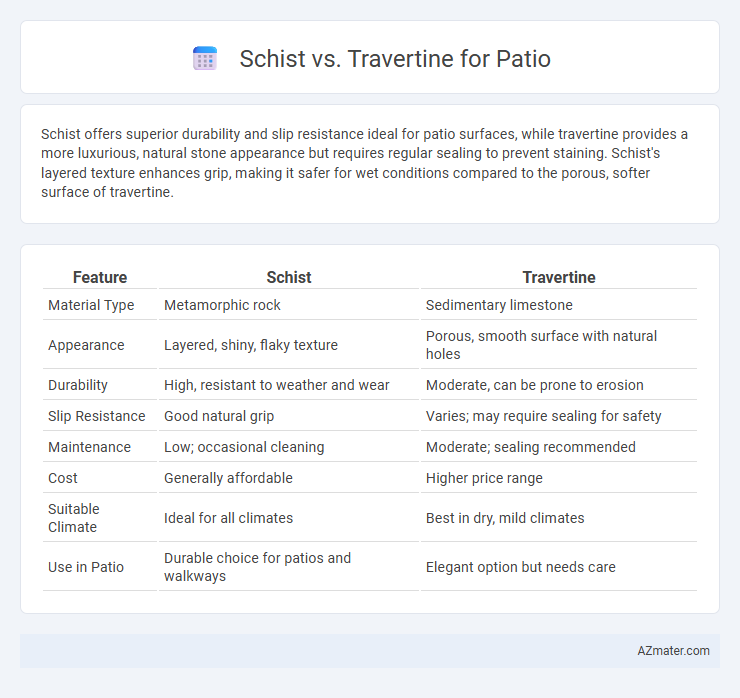Schist offers superior durability and slip resistance ideal for patio surfaces, while travertine provides a more luxurious, natural stone appearance but requires regular sealing to prevent staining. Schist's layered texture enhances grip, making it safer for wet conditions compared to the porous, softer surface of travertine.
Table of Comparison
| Feature | Schist | Travertine |
|---|---|---|
| Material Type | Metamorphic rock | Sedimentary limestone |
| Appearance | Layered, shiny, flaky texture | Porous, smooth surface with natural holes |
| Durability | High, resistant to weather and wear | Moderate, can be prone to erosion |
| Slip Resistance | Good natural grip | Varies; may require sealing for safety |
| Maintenance | Low; occasional cleaning | Moderate; sealing recommended |
| Cost | Generally affordable | Higher price range |
| Suitable Climate | Ideal for all climates | Best in dry, mild climates |
| Use in Patio | Durable choice for patios and walkways | Elegant option but needs care |
Introduction to Schist and Travertine Patios
Schist patios offer a natural, layered texture with durability suited for outdoor spaces, providing excellent slip resistance and weather tolerance. Travertine patios showcase a classic, porous surface with warm, earthy tones, valued for their timeless elegance and cool feel underfoot during hot weather. Both materials deliver distinct aesthetic and functional advantages, making the choice dependent on desired style, maintenance, and climate conditions.
Geological Origins and Composition
Schist originates from metamorphic processes where sedimentary rocks are subjected to intense heat and pressure, resulting in a foliated texture rich in mica and quartz, ideal for patios requiring durability and natural aesthetics. Travertine forms from the precipitation of calcium carbonate in mineral springs, creating a porous, sedimentary limestone with distinctive banding that offers a unique, earthy appeal for outdoor patios. The geological origin of schist ensures higher structural strength, while travertine's composition provides a softer, more weathered look suitable for decorative patio surfaces.
Visual Aesthetics and Color Variations
Schist offers a striking, natural shimmer with its layered texture and metallic flecks, creating dynamic visual interest for patios, while travertine showcases a smooth, matte surface with soft, earth-toned hues ranging from creamy beige to rich rust. The color variations in schist typically include deep grays, greens, and browns that add depth and contrast, whereas travertine's palette leans toward warm neutrals with subtle veining, enhancing a classic and elegant ambiance. Both materials provide unique aesthetic appeal, but travertine's uniformity tends to suit traditional designs, whereas schist's rugged surface complements contemporary and rustic styles.
Durability and Weather Resistance
Schist offers superior durability for patios due to its high mineral content and natural cleavage, making it resistant to cracking under heavy foot traffic and varying weather conditions. Travertine, while also durable, is more porous and requires sealing to withstand frost, rain, and UV exposure without eroding or staining. Choosing schist ensures long-lasting weather resistance with minimal maintenance, ideal for climates with frequent temperature fluctuations.
Surface Texture and Slip Resistance
Schist offers a naturally rough and uneven surface texture, providing excellent slip resistance ideal for outdoor patios in wet or humid conditions. Travertine exhibits a smoother, more porous texture with natural pits that can be filled or left untreated, offering moderate slip resistance but requiring more maintenance to prevent slipping when wet. Choosing between schist and travertine depends on balancing the desired aesthetic with safety needs in varied weather environments.
Installation Process and Labor Requirements
Schist patios require careful cutting and precise fitting due to the stone's natural foliated layers, demanding skilled labor and increased installation time compared to travertine. Travertine, with its uniform texture and standard tile sizes, allows for quicker installation and often requires less specialized labor, reducing overall project costs. Both materials benefit from professional installation to ensure durability and proper drainage, but travertine's ease of handling typically results in lower labor intensity and faster project completion.
Maintenance Needs and Longevity
Schist patios require regular sealing and cleaning to prevent weathering and maintain their polished appearance, as their foliated structure makes them more susceptible to moisture absorption and erosion over time. Travertine offers superior longevity with minimal maintenance due to its dense, porous composition that naturally resists cracking and weather damage, often needing only periodic sealing to preserve color and surface integrity. Both materials provide durability for outdoor use, but travertine's low porosity and resilience make it a preferred choice for long-lasting, low-maintenance patio surfaces.
Cost Comparison: Schist vs Travertine
Schist typically costs between $6 and $12 per square foot, making it a cost-effective choice for patio installations compared to travertine, which ranges from $10 to $30 per square foot due to its natural beauty and durability. Installation costs for both materials can vary, but travertine often requires more specialized labor because of its delicate texture, potentially increasing overall expenses. When budgeting for a patio, considering both material pricing and installation fees highlights schist as the more affordable option versus the premium pricing of travertine.
Eco-Friendliness and Sustainability
Schist and travertine both offer eco-friendly options for patio construction, but schist is a natural metamorphic rock formed under heat and pressure, requiring minimal processing, which reduces environmental impact. Travertine, a sedimentary limestone deposited by mineral springs, is abundant and recyclable, but its extraction and processing may involve higher carbon emissions compared to schist. Choosing schist can enhance sustainability through durability and low maintenance, while travertine's porous nature allows for natural temperature regulation, contributing to energy efficiency in outdoor spaces.
Choosing the Best Stone for Your Patio
Schist offers a durable and textured surface with natural slip resistance, making it ideal for patios exposed to weather variations, while travertine provides a smooth, elegant look with cooler surface temperatures, perfect for warm climates. Schist's rich mineral composition enhances its strength and longevity, whereas travertine's porous nature requires sealing to prevent staining and weather damage. Selecting the best stone depends on your local climate, maintenance willingness, and desired aesthetic, balancing schist's rugged appeal against travertine's classic sophistication.

Infographic: Schist vs Travertine for Patio
 azmater.com
azmater.com